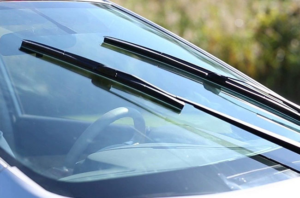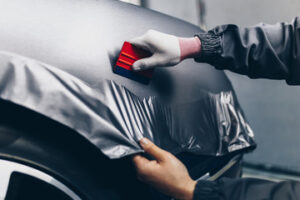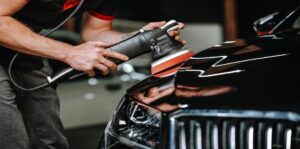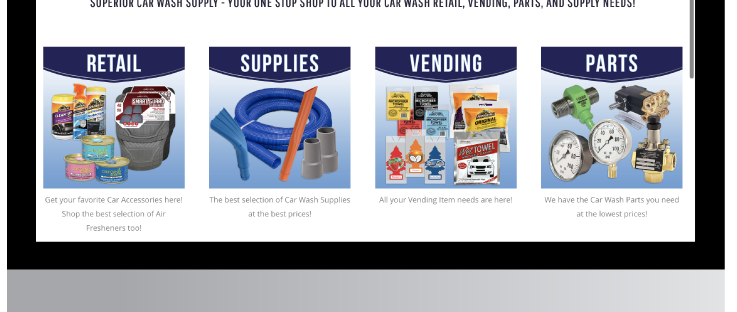When a rock flings through your windshield and leaves behind small cracks or pits, it can be a good idea to get the damage repaired. However, the location of that damage will play a major role in whether repair or replacement is a better option.
After installing a new windshield, it’s important to check the work. The molding and adhesives should be completely dry before driving. Contact Windshields Direct LLC today!

Your front windshield is made of laminate glass (several panes of glass separated by a layer of plastic). Because of this, it’s tough to shatter, and that helps make it safe for your driving vision. Nevertheless, the front windscreen can sustain chips that affect the outer layers of the windshield. A chip occurs when something like a pebble or debris hits your windshield. The impact can’t cause the glass to shatter, but it can cause tiny pieces to flake off, making a windshield chip.
Depending on the size of the pit and where it is located, you may be able to repair it at home using a windshield chip repair kit or an auto glass shop’s services. Before the technician can apply a clear resin to fill the pit, they must remove dirt or moisture from the area. They also need to ensure that the pit has not penetrated the plastic interlay section of your windshield.
Once the glass is clean, a vacuum pump is used to rid the windshield of air, and then clear adhesive resin is applied to the pit. The resin is then cured under UV light. The process is quick and typically takes less than an hour for an experienced technician to complete. Once done, the repaired windshield retains 90-95% of its original functionality.
Surface pits can be quite dangerous if left unattended, leading to ever-expanding cracks that obstruct the driver’s field of vision. Getting pits filled by a professional as soon as possible is important.
A combination break is a large area of damage that contains both a pit and a crack. These damages can be very difficult to fix and often indicate that the glass has been compromised. Getting it replaced is usually the best option. However, consult a professional to determine if the damage can be salvaged. If not, they will recommend a replacement.
Bullseye chips are one of the most common forms of windshield damage. These rock chips look like a circle with a well-defined pit at the center, typically affecting only the outer layer of glass. The good news is that they’re usually repairable, especially if they’re repaired immediately.
The downside to bullseye chips is that they often create new cracks that spread across the glass. If left unattended, they can grow into a full crack that threatens the strength of your windshield and obstructs your view while driving.
Windshields are exposed to a lot of stress during everyday use. This is why they’re susceptible to damage, even from small rocks and debris. Windshields are also a frontline warrior against dust, dirt, rocks, bugs, and other hazards on the road. Regardless of the size or location of a ding, it’s always important to have it checked out by an experienced technician.
If the ding is in the “danger zone,” within the driver’s line of vision, or near the wiper blades, it may need to be replaced. In most cases, though, your insurance company will cover the cost of a replacement without raising your premium or increasing your deductible.
Sometimes called “crater pits,” deep gouges appear in the windshield but don’t penetrate through the tempered glass or plastic inner layer. These can be repaired using traditional auto glass repair methods if the damaged area is less than an inch in diameter and doesn’t sit within the driver’s field of vision.
If your windshield is adorned with a pattern resembling a starburst, it’s likely a star break. These rock chips have a singular point of impact with straight lines that radiate out from the center of the damaged area. Star breaks are repairable but more complex than bullseye or half-moon chips, so a professional must apply the resin.
Combination Chips
You’ll need to act fast if your windshield displays the telltale signs of a star break. This type of crack features a central impact point surrounded by smaller, tentacle-like cracks extending outward. Star breaks require immediate attention because, when left unattended, they easily spread.
They can also obstruct the driver’s view, making it hard to see and react quickly to changing road conditions and hazards. Getting your star breaks fixed prevents them from spreading, saving you money and preserving the integrity of your windshield.
Star breaks are common in windshields and are typically caused by small debris that hits the glass at high speed. They can appear from a full bull’s eye with a dome-like center to a half-moon crack. They can also take on a more starburst-like appearance with small, straight cracks extending outward from the central point of impact.
These cracks are typically easy for a professional to repair if they don’t extend more than 18 inches from the edge of your windshield. However, if they do, this will likely indicate that the crack is beyond repair and needs to be replaced.
It’s important to note that, unlike chips, cracks that spread can be quite dangerous. This is because they weaken the structure of your windshield, causing it to become more susceptible to further damage. This may be triggered by temperature fluctuations, vibrations, changes in air pressure, or even poor windshield repair.
Generally, any crack over an inch in length should be repaired as soon as possible to minimize the risk of further damage and keep your vehicle safe for driving. If you need help assessing the severity of your windshield cracks, consult an expert. They’ll be able to recommend the best course of action.
While windshields can be replaced, the best course of action depends on the severity of the damage. Most windshields are made of laminated glass with a plastic layer in between, called tempered glass. While this type of glass is less likely to shatter into granular pieces, it does not hold up well to direct impact from large debris or sudden temperature changes. Windshield cracks typically result from these incidents and may require a full replacement.
Cracks in windshields can also worsen over time if left unaddressed. This is due to an effect known as spider-webbing, where small dirt particles find their way into the cracks and cause them to expand slowly. To prevent this from happening, you should keep your vehicle parked in a garage or covered area and avoid blasting the interiors with hot or cold air.
Small surface pits that do not affect visibility can usually be repaired with resin injection, completed in under an hour. However, any crack close to the driver’s line of sight or that extends across the windshield should be addressed immediately. Cracks that cross the center of the windshield tend to spread more quickly and are more difficult to repair.
Windshield damage is common and often occurs while driving on rough roads or when passing trucks or other vehicles forcefully hit their windshields. It is common for rocks and other debris to fly off the tires of passing cars, striking the windshield with considerable force. Even if an airbag protects your windshield, this impact can still damage it.
You should make an appointment to have small chips or cracks repaired as soon as you notice them. This will prevent them from spreading and help you avoid needing a windshield replacement. You can also protect your windshield by preventing sprinklers and rain and placing clear tape over the affected area to keep moisture from seeping in. This will also help prevent the cracks from becoming obstructive and impairing your vision while driving.



